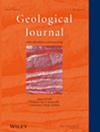Rare earth element fractionation in volcanic rocks can be used to recognise both petrogenetic processes and tectonic settings. We present a simple geochemical modelling approach using CeYb proxy employing the Magma Chamber Simulator tool and the binary mixing model to understand the range and the limits of variation in the enrichment of incompatible trace elements, brought about in evolved magmas by differentiation processes in known Phanerozoic tectonic settings in conjunction with the ThNbYb proxy. By extending this approach to the volcanic rocks of the Meso-Neoarchean greenstone belts it is observed that rocks, which fall beyond the limits set by binary mixing and fractional crystallisation in a bivariant trace element plot were most likely generated by the modification of the mantle source by subducting slab-derived fluids prior to the melting of the source and the diversification of the magmas into differentiated rocks. Subduction–accretion process was established at least by the Meso-Neoarchean. The greenstone belts of the Dharwar and Yilgarn cratons represent Archean analogues of oceanic crust that were predominantly emplaced in a convergent-margin tectonic setting and probably acted as suture zones that juxtaposed continental crustal masses by horizontal tectonic forces.



